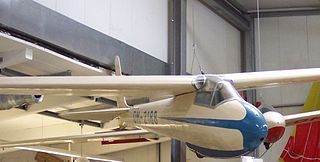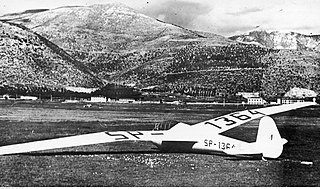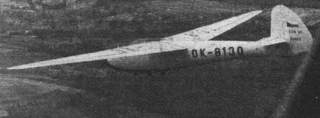
The 1940 Summer Olympics, officially known as the Games of the XII Olympiad, was a planned international multi-sport event scheduled to have been held from 21 September to 6 October 1940, in Tokyo City, Japan, and later rescheduled for 20 July to 4 August 1940, in Helsinki, Finland following the outbreak of the Second Sino-Japanese War in 1937. They were ultimately cancelled because of World War II alongside the 1940 Winter Olympics in Sapporo, Japan, and were the third games to be cancelled due to war.
Hans Jacobs was a German sailplane designer and pioneer. He had been taught sailplane design by Alexander Lippisch, designer of many gliders during the 1920s and the 1930s. As the head of the Deutsche Forschungsanstalt für Segelflug at Darmstadt in the years before World War II, he was responsible for a number of highly successful designs, including the DFS Rhönsperber, DFS Rhönadler, DFS Habicht, DFS Weihe, DFS Kranich, and the DFS 230 assault glider. Hans also designed a glider-seaplane, the "Sea Eagle", test flown by Hanna Reitsch. In 1936, Hans developed self-operating dive brakes, on the upper and lower surface of each wing, for gliders. He designed the DFS 230 used in the Battle of Fort Eben-Emael.

The Deutsche Forschungsanstalt für Segelflug, or DFS, was formed in 1933 to centralise all gliding activity in Germany, under the directorship of Professor Walter Georgii. It was formed by the nationalisation of the Rhön-Rossitten Gesellschaft (RRG) at Darmstadt.

Olympic sports are sports that are contested in the Summer Olympic Games and Winter Olympic Games. The 2024 Summer Olympics included 32 sports; the 2022 Winter Olympics included seven sports. Each Olympic sport is represented at the International Olympic Committee (IOC) by an international governing body called an International Federation (IF).

The DFS Olympia Meise was a German sailplane designed by the Deutsche Forschungsanstalt für Segelflug (DFS) for Olympic competition, based on the DFS Meise.
Contrary to the methods used by the Reich Air Ministry (RLM) for the allocation of aircraft designations, the designers and manufacturers of sailplanes and gliders in Germany enjoyed the freedom of choosing their own designations for their products up until 1945.

Gliding is a recreational activity and competitive air sport in which pilots fly unpowered aircraft known as gliders or sailplanes using naturally occurring currents of rising air in the atmosphere to remain airborne. The word soaring is also used for the sport.
Chilton Aircraft Ltd was a British aircraft design and manufacturing company of the late 1930s and 1940s.

Heini Dittmar was a record-breaking German glider pilot.
The Slingsby T.25 Gull 4 is a British glider designed and built by Slingsby that first flew in 1947.
Elliotts of Newbury was a British company that became well known for manufacturing gliders.

The Eon Olympia was a glider produced from 1947 by Elliotts of Newbury.
Anne Burns was a British aeronautical engineer and glider pilot. She had a career of nearly 40 years in the Royal Aircraft Establishment as an engineer and an expert in wind shear. As a glider pilot, she holds the British record for highest altitude, and was the first woman to cross the English Channel in a glider.

Akaflieg Berlin is one of around thirteen flying groups, or Akaflieg, currently attached to German universities. Akaflieg Berlin, is the abbreviation of Akademische Fliegergruppe Berlin e.V., a group of students enrolled at several Berlin universities, though they are mainly from TU Berlin, who are involved with the development and the design of gliders, as well as research in aerodynamics. Founded in 1920 Akaflieg Berlin is one of the oldest gliding clubs in Germany, flying their gliders from Kammermark airfield near Pritzwalk, which they share with the AFV Berlin, which mainly consists of former members of Akaflieg Berlin, jokingly referred to as the “elderly ladies and gentlemen”. As at 2007/2008 Akaflieg Berlin was the executive group of the Idaflieg, the controlling body for all German university flying groups.

The Warsztaty Szybowcowe Orlik, also known as the Kocjan Orlik after the designer, is a family of Polish gull winged gliders that was designed by Antoni Kocjan and produced by Warsztaty Szybowcowe.

The CVV-4 Pellicano was a single seat Italian glider designed for a competition to select an aircraft for the 1940 Olympic Games. The DFS Olympia Meise was preferred to it after the trials in Italy in 1939.

The Zlín Šohaj series of club gliders began as a post World War II development of the DFS Olympia Meise. A large number were built in the 1940s and '50s.

The Rotter Nemere or just Nemere was a Hungarian high performance, single seat sailplane designed and built for the 1936 ISTUS gliding demonstration held in 1936 alongside the Berlin Olympic Games.












